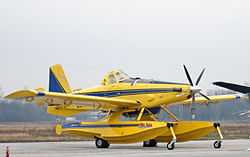Croatian Air Force and Air Defence
| Croatian Air Force and Air Defence | |
|---|---|
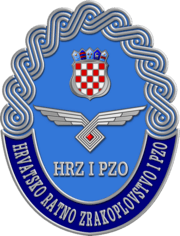 Croatian Air Force and Defence emblem | |
| Active | 1991 |
| Country | Croatia |
| Size | 2,000 personnel [1] |
| H/Q | Pleso Airbase, Zagreb |
| Motto | Hrvatskim nebom bdiju i plove (Croatian Sky they Guard and Fly) |
| Anniversaries | December 12 |
| Equipment | 94 aircraft |
| Engagements |
Croatian War of Independence: * Siege of Dubrovnik * Operation Maslenica * Operation Winter '94 * Operation Flash * Operation Storm Bosnian War * Operation Mistral 2 KFOR |
| Commanders | |
| Current commander | brigadier general Dražen Šćuri (acting) |
| Notable commanders | General Imra Agotić |
| Insignia | |
| Roundel |
 .svg.png) |
| Fin Flash |
 .svg.png) |
| Aircraft flown | |
| Fighter | MiG-21BisD/UMD |
| Patrol | Bell 206B-3, Pilatus PC-9M |
| Trainer | Pilatus PC-9M, Zlin 242L, Bell 206B-3 |
| Transport | An-32B, Mi-8 MTV-1, Mi-171Sh |
The Croatian Air Force and Air Defence (Croatian: Hrvatsko ratno zrakoplovstvo i protuzračna obrana) is a branch of the Croatian Armed Forces.
Aviation history
The Croatian Air Force as it is known today was established on 12 December 1991, during the Croatian War of Independence. After 2003, a large portion of the fleet was modernized or completely overhauled and the rest of the outdated fleet was retired. Croatia also acquired new-build transport helicopters, fire-fighting aircraft and basic training aircraft during this time. The planned acquisitions for additional fixed- and rotary-wing transports and fighter aircraft were, after repeated postponements, cancelled due to a difficult economic situation.
Duties
The primary role of the Croatian Air Force and Air Defence is securing the sovereignty of Croatian air space and providing air support to other services during joint operations. It operates the integrated Croatian Air Defence system. Other tasks include providing help in natural, humanitarian and technological disasters, search and rescue operations, and support to other government agencies.
Commanders
Commanders of the Croatian Air Force since its establishment in 1991:
- Imra Agotić (1991–1996)
- Josip Čuletić (1996–2001)
- Josip Štimac (2001–2002)
- Viktor Koprivnjak (2002–2007)
- Vlado Bagarić (2007–2011)
- Dražen Šćuri (2011–present)
Structure
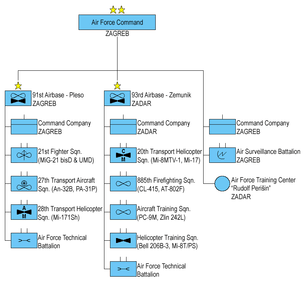
- Air Force Command[2]
- Command company
- 91st Air Force Base – Pleso, Zagreb
- Command company
- 21st Fighter Squadron – MiG-21bisD/UMD
- 27th Transport Aircraft Squadron – An-32B
- 28th Multirole Helicopter Squadron – Mi-171Sh
- Air Force Technical Battalion
- 93rd Air Force Base – Zemunik, Zadar
- Command company
- Transport Helicopter Squadron of the 93rd Air Force Base – Mi-8 MTV-1
- 885th Firefighting Squadron – CL-415, AT-802
- Fixed-Wing Aircraft Squadron – PC-9M, Zlin 242L
- Helicopter Training Squadron – Bell 206B-3, Mi-8T
- Air Force Technical Battalion
- Air Surveillance Battalion
- Air Force Training Center
Status
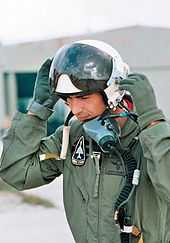
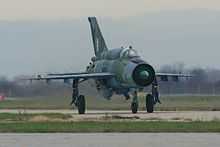
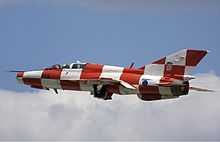
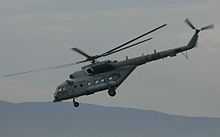

The core of the air force is a squadron of 12 modernized MiG-21bisD/UMD fighters. In 2003, a minor upgrade and an extensive overhaul were performed in Romania, incorporating navigation and communication elements of the Lancer standard to make them interoperable with NATO air forces. The aircraft received no upgrade to their weapons systems. Despite initial plans to replace the MiG-21 fleet with a multirole aircraft in 2013 (delayed from 2011 due to the financial crisis) and an official tender having been issued in 2008, ongoing budgetary constraints have resulted in an abandonment of these plans. As a cost-saving measure, a decision was made to again overhaul seven serviceable airframes already in service and supplement them with five additional airframes from Ukrspetsexport. This temporary measure will see the fleet remain in service only until 2019-2020.
Pilot training is conducted on two types of aircraft. During late 2007, five new Zlin 242L Aerobatic basic trainers were acquired in order to replace a fleet of seven old Utva 75s (four had already been retired previously). The deal was worth just under $2 million. An option for three additional basic trainers was considered but has not been exercised. The backbone of the training fleet, however, is built around 20 Pilatus PC-9M advanced trainers which also constitute the most numerous type of aircraft in Croatian service. These were ordered in 1997 (3 were former RAAF PC-9A examples converted to PC-9M standard immediately upon delivery) and entered full service a year later. The deal was worth around $100 million. They are also operated by the national aerobatic team called Krila Oluje / Wings of Storm. The current fleet size and facilities at Zemunik airbase allow the Croatian Air Force to offer advanced pilot training to other countries but the lack of HUDs, HOTAS and hardpoints on Croatia's PC-9Ms, however, limits the usefulness of Croatia's advanced training programme. Such upgrades might be financially plausible once surplus PC-9Ms get sold. Nonetheless, on March 5, 2014, representatives of the Croatian Air Force signed an agreement with their partners from the Royal Air Force of Oman for the future training and education of 16 Omani pilots on the Croatian fleet of Pilatus PC-9Ms. The training itself started on March 10, is planned to be concluded by December 26, 2014 and will see each pilot log 150 flight hours during the ten-month period. As a cost-saving measure, the Croatian government has announced in its long-term defence plan that it plans to downsize the PC-9M fleet to a "suitable level" for the current air force fleet, substantially reduced since the mid-1990s. Consequently, six oldest units are offered for sale while the 14 remaining aircraft are due to remain active and possibly undergo an upgrade.
The Croatian Air Force operated two Antonov An-32B tactical transports (built in 1991 and 1993) until 2013. Both aircraft underwent a two-stage modernization in 2004 and 2007. They were fitted with NATO-standard navigational and communication equipment, additional systems for loading/unloading and flare dispensers. They had performed humanitarian and paratrooper missions as well as supporting Croatia's international military commitments such as for ISAF and KFOR. Due to budget limitations both aircraft have been offered for sale.[3] In the draft of the strategic defence review, the Croatian government announced that no new tactical transport aircraft would be purchased before 2020 leaving Croatia reliant on its NATO partners for fixed-wing transport.
The helicopter fleet is equipped mainly with Russian-built Mi-17s and its derivates. The fleet includes three Mi-8 and 11 Mi-8MTV-1 (also known as Mi-17-1V) cargo helicopters, which underwent overhauls between 2003 and 2005. A batch of 6 Mi-8MTV-1 underwent an overhaul again in 2013 and 2014, while the remaining 8 units are to follow in 2014 and 2015. The Croatian Ministry od Defence is currently considering the option of selling all Mi-8 helicopters upon overhaul and replacing them with up to 15 UH-60L after 2017.[4]
In 2006, a deal to deliver 10 new Mi-171Sh transport-attack helicopters was signed with Russia, itself a partial payment for an old Russian debt. The order itself was worth $66 million. The new type differs from the ones already in service in having a cargo ramp instead of clamshell doors, larger side doors, flare dispensers, additional armor around the cockpit and cargo compartment, night vision device equipment, door gunner posts, rocket launchers etc. The entire squadron of 10 helicopters entered service by July, 2008. Two additional VIP helicopters were planned for 2009 but their acquisition was cancelled.
After more than 10 years in the Croatian service and great success in Operation Storm, the government finally decided to retire a squadron of seven Mi-24V helicopters in 2005 due to a costly modernization. Six are offered for sale at a price of $83,000 per aircraft, while one was sent to a museum. The role of an armed support helicopter was taken over by new Mi-171s but the entire attack helicopter squadron is to be revived in 2015 with the acquisition of up to 16 OH-58D.[5]
While visiting Israel in November 2006, Croatian delegation agreed to buy two mid-size, state-of-the-art Hermes 450 and four small Skylark UAVs. Additional cameras, computer systems, spare parts and a ground station were also obtained. Two additional Skylark UAVs entered service in 2009. As of December 2012, additional Skylarks has been reported in service though no public records or images of Croatian Hermes 450 are available. This suggests that the order was cancelled due to funding issues.
After a horrible fire season during the summer of 2007 (12 firefighters lost their lives on a small island of Kornati), Croatia agreed to buy two new Canadair CL-415 and five Air Tractor AT-802 water bombers. These joined a fleet of four relatively new amphibians already in service. The entire deal was projected at $70 million. By making such an acquisition, Croatia became the leading power in aerial firefighting on the Mediterranean in respect to its population and surface.
MiG-21 replacement acquisition
Although the MiG-21 was perceived as an outdated fighter by the Croatian Air Force even in the late 1990s, budget constraints have been continuously deferring any final decision on the acquisition of a new fighter type. Seen as Croatia was no longer facing any military threat by 1999, serious talks were started with Israeli firms to extensively upgrade the fleet of 24 MiG-21bis/UM fighters to a "Lancer 3" standard instead of buying a completely new combat aircraft. Although the initial information suggested that such a decision was practically final, no agreement was reached. By late 2002, all MiG-21s, however, were reaching the end of their service lives and it was decided that the fleet be overhauled and lightly upgraded in Romania. A squadron of 12 older aircraft (produced between 1972 and 1976) was therefore sent for 10-year life prolongment repairs to Aerostar after which a second squadron of 12 younger airframes (produced between 1977 and 1981) was to follow. After the first squadron arrived to Croatia, no further moves were made in order to revamp the second squadron and the aircraft belonging to it were left to rot under the open sky at Pleso Airbase in Zagreb. Ironically, by not proceeding with the initial plans to repair both squadrons, Croatia invested money into those aircraft that were older and in worse condition while the younger and better preserved MiGs were literally destined to decay.
Seen as the fleet of 12 overhauled MiG-21s was originally planned to remain active only until late 2011, Croatia was eyeing a replacement aircraft already by late 2008. It was projected that a new type be selected by late 2009 and that first aircraft start entering service by 2011. Such plans were put into question by the arrival of the global economic crisis which severely affected the Croatian economy and in late 2010 it was officially unveiled that no new aircraft were envisaged to enter service. Perisistant efforts from various parties to convince the Croatian Government to buy new or second-hand aircraft kept the possibility of such an event really occurring - viable. After numerous offers (among which for up to 20 German F-4 Phantoms, new or second-hand Swedish Saab Gripens, Dutch and American F-16s, retired Hungarian MiG-29s, even French Mirage F-1s) the Defence Ministry finally announced in June 2013 that the Ukrainian firm Ukrspetsexport will provide Croatia with 8 single-seat and 4 twin-seat upgraded MiG-21 aircraft. Due to their condition only 7 of these will be refurbished Croatian air frames and the remaining 5 will be '"new'" aircraft. These are to remain in service by 2020 but the decision on the replacement fighter type is to be made by the end of 2016. [6] [7]
Current modernization and procurement programs
- Acquisition of up to 16 OH-58D Kiowa Warrior scout/attack helicopters from US Army stock, to be delivered in 2015.[8]
- Overhaul of the existing fleet of 14 Mil Mi-17 transport helicopters (11 Mi-8MTV-1 and 3 Mi-8T) during 2013-2015. Initial six helicopters have been overhauled by 2014 for 81 million Croatian Kuna and the remaining eight are to follow. Cost of program - 200 million Croatian Kuna. However Defence minister Ante Kotromanovic is holding talks with the US on the possibility of purchasing 15 used UH-60 Black Hawk helicopters.[9] These would replace older Mi-17 helicopters currently in service but scheduled to undergo overhaul in 2015, cost of which is uncertain due to difficulties in acquiring spare parts and dependence on Russia's willingness to overhaul or supply spare parts thus undermining Croatia's own national interests and security. If Black Hawks are purchased Croatia would sell its older Mi-17 helicopters to third parties for roughly 5 million USD per unit.
- Modernization of the combat aircraft fleet. It was decided to overhaul the current fleet of MiG 21 and purchase additional aircraft as an interim solution till 2019-2020 when a new fighter will be purchased. Cost of program – 105 million Croatian Kuna.[10]
- Plans to purchase at least one SAM battery with a range that exceeds 10 km, most likely candidates are Crotale NG or second hand systems from a number of NATO allies. Cost of program - unknown [11] although there are plans to move entire air defence segment of the air force to land forces component of Croatian Armed Forces thus reducing the number of service personal in the air force.
- Integration of AN/FPS-117 Radar network in to NATO Radar network consisting of 5 radar stations across Croatia - 50 million Kuna.[11]
Aircraft
Current inventory
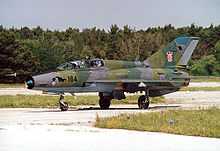
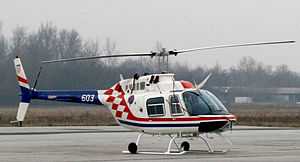
| Aircraft | Origin | Type | Variant | In service | Notes | |
|---|---|---|---|---|---|---|
| Combat Aircraft | ||||||
| MiG-21 | |
fighter | MiG-21bis/ UMD | 7[12] | ||
| Aerial Firefighting | ||||||
| CL-415 | |
water bomber | 6[12] | |||
| AT-802 | |
fire suppressor | 5[12] | |||
| Helicopters | ||||||
| Mil Mi-17 | transport / SAR | Mi-8/17/171 | 22[12] | |||
| Trainer Aircraft | ||||||
| PC-9 | |
trainer | 17[12] | |||
| Bell 206 | trainer | 8[12] | ||||
Aircraft that have been retired
- 20+ Mikoyan-Gurevich MiG-21- used for spare parts
- 2 Soko G-2 Galeb – retired in 1996 due to the lack of spare parts
- 1 Soko J-21 Jastreb – retired in 1996 due to the lack of spare parts
- 1 Soko J-20 Kraguj – retired due to overall obsolescence in 1996
- 1 Lola Utva 60 – retired in 90's
- 4 Lola Utva 66 – retired in 90's
- 11 Lola Utva 75 – put out of service recently, replaced by Zlin 242L
- 3 Canadair CL-215 Scooper – last retired in 2004, replaced by Canadair CL-415 Superscooper
- 2 Air Tractor AT-400 – retired in 1993
- 1 Dornier Do 28 – retired in 2004
- 1 Dassault Falcon 10 – replaced by Bombardier Challenger 600
- 11 Antonov An-2 – handed over to aeroclubs throughout the years, some can be called into service
- 4 Cessna 172 – retired in 1997
- 2 Cessna A.188B Agwagon – retired in 1992
- 1 Cessna T.210N Centurion – retired in 2004
- 4 Piper PA-18 Super Cub – retired in 1996
- 2 Piper PA-25-235 Brave – retired in 1992
- 3 Piper PA-28 Warrior – retired in 1997
- 1 Piper PA-31P – retired in 2005
- 2 Piper PA-36 Pawnee Brave – retired in 1992
- 2 PZL M-18 Dromader – retired in 1992
- 9 Mil Mi-24D/V – withdrawn in 2002 (Mi-24D) and 2005 (Mi-24V), 6 up for sale
- 7 Mil Mi-8T/S – used for spares
- 3 Agusta Bell 212 – transferred to the Croatian Police
- 4 MD Helicopters MD 500 – last retired in 2001, replaced by Bell 206
- 1 Agusta-Bell AB.47J-2A – retired to museum in 1992
See also
- History of Croatian Air force
- Austro-Hungarian Imperial and Royal Aviation Troops
- Yugoslav Royal Air Force
- Air Force of the Independent State of Croatia
- Croatian Air Force Legion
- Yugoslav Partisans
- Balkan Air Force
- Yugoslav Air Force
References
- Lisko, T. and Canak, D., Hrvatsko Ratno Zrakoplovstvo u Drugome Svejetskom Ratu (The Croatian Airforce in the Second World War) Zagreb, 1998 ISBN 953-97698-0-9.
- Savic, D. and Ciglic, B. Croatian Aces of World War II Osprey Aircraft of the Aces – 49, Oxford, 2002 ISBN 1-84176-435-3.
Notes
- ↑ http://www.osrh.hr/prikaz_hr.asp?go@=774&Uvf=4
- ↑ "Orbats - Scramble". Retrieved 24 December 2014.
- ↑ Air Forces Monthly, Feb 2013 Edition, Key Publishing
- ↑ http://www.defender.hr/republika-hrvatska/oruzane-snage/nema-sumnji-dolaze-kiowa-warriors-dok-ce-uh-60-black-hawk-pricekati-dvije-godine.php
- ↑ http://www.defender.hr/republika-hrvatska/oruzane-snage/nema-sumnji-dolaze-kiowa-warriors-dok-ce-uh-60-black-hawk-pricekati-dvije-godine.php
- ↑ Reed Business Information Limited. "Croatia to refurbish MiGs, delaying new combat type". Retrieved 24 December 2014.
- ↑ "Ukraine wins tender to repair Croatian MiG-21 fighters" June 26, 2013
- ↑ "JUTARNJI DOZNAJE: MINISTAR KOTROMANOVIĆ PISAO PENTAGONU Hrvatska traži od SAD-a 16 borbenih letjelica - Jutarnji.hr". Retrieved 24 December 2014.
- ↑ http://www.jutarnji.hr/umjesto-ruskih-mi-8--morh-zeli-polovne-black-hawke/1194369/
- ↑ "Remont sedam migova i nabava još pet za 13,9 milijuna eura". Večernji.hr. Retrieved 24 December 2014.
- ↑ 11.0 11.1 "HV će imati bojnu od 500 vojnika za ratovanje u svijetu". Večernji.hr. Retrieved 24 December 2014.
- ↑ 12.0 12.1 12.2 12.3 12.4 12.5 "World Air Forces 2015 pg. 14". Flightglobal Insight. 2015. Retrieved 26 December 2014.
External links
| Wikimedia Commons has media related to Air force of Croatia. |
- Official website (English version)
- War is Boring
| ||||||||||||||||||||||||||||||||
| ||||||||||||||||||||||||||||||||||||||||||
| ||||||||||
